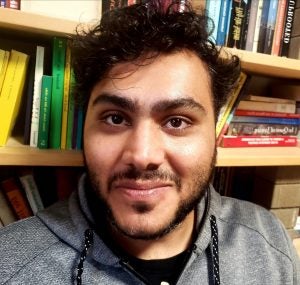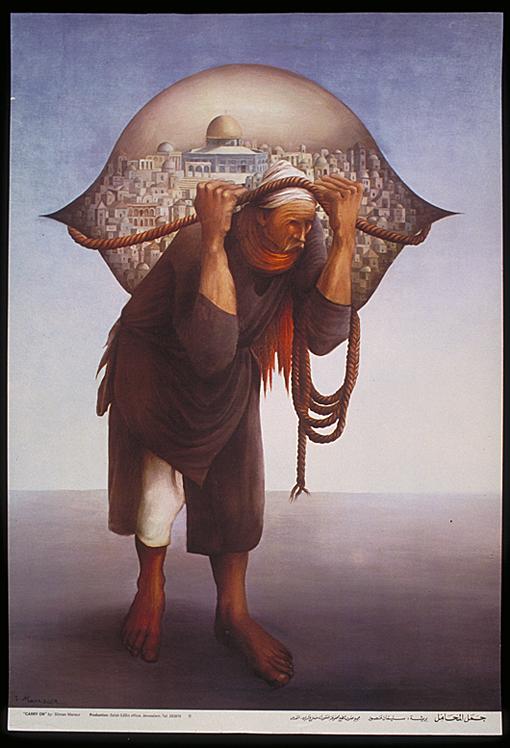An interview with CCAS Qatar Postdoctoral Fellow Adey Almohsen on his research historicizing Palestinian thought in the years between the Nakba and the Six Day War
By Vicki Valosik
Why did you choose to focus on the period between the 1948 Nakba and the 1967 War in your research?

Almohsen: Much of the recent historiography on modern Palestine focuses on either: 1) the late Ottoman and British mandatory eras and the years leading to the 1947-9 Nakba and the establishment of Israel or, 2) the period following the Arab defeat (Naksa) in the 1967 Six Day War, which saw the rise of the Palestine Liberation Organization (PLO) and the intensification of the transnational Palestinian Revolution. The historiographical gap thus emerging spans the two decades separating Nakba from Naksa—or what Rashid Khalidi labeled as the “lost years.” My book project, Minds in Exile: An Intellectual History of Palestinians 1945–70, argues that much of our contemporary notions of Palestinian history and identity had their roots in this period, and that the intellectual debates of those years hold the key to understanding why certain visions of Palestinian identity have proven dominant.
While historians often work against ruptures in the line of time and instead point to contingencies and continuities between one historical moment and the next, the Nakba—at least with regard to Palestinian history—is a rather schismatic event that altered what it means to be Palestinian: socially, politically, psychologically, and culturally. It isn’t surprising, therefore, that Palestinian thought after the Nakba took on new meanings and proceeded from different priorities. Palestinian intellectuals were faced with the task of processing not just the Nakba’s human scale—e.g., the violent dispossession and depopulation of three-quarters of a million Palestinians—but, significantly, its multitudinous effects on their individual lives as stateless exiles and refugees in a still-decolonizing Arab world. Yet, despite the odds stacked against them to critique, compose, and publish, Palestinians managed to do so in ways that redrew the Arab world’s intellectual map. In my forthcoming book, I historicize this messy process of Palestinian-Arab-global intellectual and literary exchange and investigate its tensions and antinomies between 1948 and 1967.
How did the literature produced during that era contribute to ideas about Palestinian identity, and how did Palestinians view the Nakba in intellectual terms?
Almohsen: I’ll answer by taking the example of Palestinian poet, critic, artist, and novelist Jabra Ibrahim Jabra (1919–94). In January 1948, Jabra and his family narrowly escaped death after the terrorist bombing of the Semiramis Hotel in West Jerusalem and fled the violence in Palestine with nothing more than a “battered suitcase,” containing “books, papers, a small box of paints and brushes, and half a dozen paintings on plywood” (Mejcher-Atassi, 2023). By way of Damascus and Amman, Jabra eventually settled in Baghdad, where he’d stay until his death in 1994. Yet, in what could be seen as part of the dark irony of Palestinian being, his Baghdad house—along with the papers and paintings he’d produced there since the Nakba—would suffer a fate like that of his Jerusalem home and was destroyed in a car bomb in the waning days of the US invasion of Iraq.

Though Jabra died before seeing it multiply in scope and in cruelty, he compared the effects of the original Nakba to the flood of Noah in its devastation. At the same time, his works reveal his conviction in the Nakba’s productive potential and as a harbinger of possibility, and Jabra was confident that from its ashes, Palestinians would emerge as renewed individuals. Indeed, on the tenth anniversary of the Nakba, Jabra argued in Shi’r magazine that Palestinians, “despite wounds and afflictions and despite being cut off from Palestine,” were steadily discovering and rediscovering themselves.
Jabra’s fascination with the individual-as-creator and his deep-seated belief in individuality could be viewed as the outcome of his intellectual leanings and political affinities. While this holds some weight, I argue that Jabra’s centering of individuality should be understood as the outcome of his experience of exile—a traumatic response to his banishment in the wake of the Nakba and to the discrimination he faced firsthand. Although he was an educated Palestinian, he could never be perceived as such, but was instead viewed as a wanting refugee possessing a dangerous intellect.
Despite the messiness of the Palestinian intellectual scene after the Nakba, much of Palestinian historiography continues to investigate Palestinians as a coherent unit. At a basic level, this historiographical unification is not surprising when one is trying to write into history a people long denied their beingness—and whose beingness is now under unrepentant, criminal bombardment. Yet exile and catastrophe do not homogenize their subjects, which is why my research seeks to write Palestinian subjects as individuals, first; and as members of an ambiguous, ever-sprawling nation-in-exile, second.
My main contention, thus, is to rethink the Nakba as not merely a unifying event within Palestinian history but an individuating one as well—a moment that brought into sharp relief for its first wave of victims (including Jabra and a score of other Palestinian figures I investigate in my book) the importance of individual freedom, self-making, self-renewal, self-constitution, and, by extension, self-determination. To rethink the Nakba in this way is not to ignore its lethal gravity or tragic upshots from 1948 to the present. Rather, this rethinking is about rejecting nationalist beginnings and understanding nation as a subjective, malleable entity.

What can your research reveal about the current Israeli war in Gaza?
Almohsen: Israel’s ongoing genocidal campaign against Gaza has dreadfully made my research topic—which looks at how Palestinians reacted in intellectual terms to the attempt to raze their existence in 1948—all the more poignant. Indeed, Israeli forces have so far killed dozens of Palestinian poets and academics and wrecked countless libraries, universities, and cultural sites in hopes of disabling any possibility of Palestinian intellectual reaction. Yet what never ceases to fascinate me—and what Israel continually fails to grasp—is the intellectual tenacity of the Palestinian people; a tenacity that is arguably more productive and more perennial than other displays of Palestinian tenacity. Yet, as we all witness the murder of Gaza’s Palestinians in mass, I hope, through my book, to write against the unrelenting attempts to massify Palestinians—either into a mass of hapless victims in need of saving or into a mass of savage terrorists in need of eradication. Against the flattening of Palestinian livelihoods and diversities, my book reckons with how Palestinian thinkers asserted their individuality and humanity in the wake of the historic Nakba, which is now dwarfed by Gaza’s 2023–2024 Nakba.
Dr. Adey Almohsen is a cultural and intellectual historian of the Arab world from the eighteenth century to the present. He is the 2023-4 Qatar Postdoctoral Fellow at CCAS. In 2024-5, he’ll finish writing his book and publish it with the support of a fellowship from the American Council of Learned Societies.
This article was published in the Fall 2023-Spring 2024 issue of the CCAS Newsmagazine.